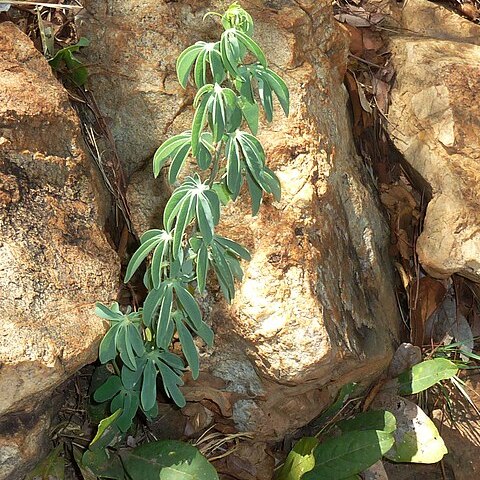Female flower: (9)10–15 × 2–3 mm. (incl. the 1·5–4 mm. long stipe), tubular-infundibuliform; hypanthium 1·5–2 mm. long; calyx-tube 0; sepals 7–9 mm. long, lanceolate, obtuse, subentire; petals 4–5 × 0·5–1 mm., lanceolate, acute, 1-nerved, irregularly serrulate at the apex; corona of sparse thick hairs; staminodes 2–3·5 mm. long, connate at the base; disk-glands 0; pistil 6–8 mm. long; gynophore 1–2 mm. long; ovary 2·5–4·5 × 2·5–4 mm., subglobose; styles shortly connate at the base, with the arms 1–1·5 mm, long; stigmas c. 1·5 mm. in diameter, subglobose, papillate.
Male flower: (13)15–30 × 2–4 mm. (incl. the 3–7 mm. long stipe), infundibuliform; hypanthium (1)2–4 × 2–3 mm.; calyx-tube 0; sepals (8)10–18(20) mm. long, lanceolate, obtuse, entire; petals 5(6), 6–11 × 1·5–2·5 mm., lanceolate, acute to obtuse at the apex, narrowed to the base, 1–3-nerved, serrulate; corona a fringe of fairly thick hairs 0·5–1 mm. long; stamen-filaments (3)4·5–7 mm. long, ± long-connate at the base, inserted at the base of the hypanthium; anthers 3–5·5 × 1 mm., apiculate; disk-glands 0; vestigial ovary 0·5–1·25 mm. long (incl. the gynophore).
Leaf-lamina 2–12 ×2·5–12 cm., 5-partite to the base, suborbicular in outline, membranous to coriaceous, greyish, glaucous or purplish-grey, sometimes punctate, with 5 main nerves from the base; petiole (0·5)1–5 cm. long; leaf-segments 1–7 × 0·5–3·5(4·5) cm., ovate to oblong, obtuse, sometimes retuse at the apex, margin entire, acute or subacute at the base, with 4–8 pairs of lateral nerves and rather distinct reticulation.
Glands of the lamina-base 2, 1–2 mm. in diameter, contiguous, on two ± connate, ± fleshy, brownish auricles; lamina-glands 1–3(5), c. 0·25 mm. in diameter, apical or subapical at the extremities of the nerves.
A shrub or climber. It grows attached to other plants. It grows 3 m tall. It grows from a short fat trunk. The flowers are green or yellow. They have a sweet scent. The fruit are orange.
Climber, sometimes shrub-like, up to 3·5 m. high, with the basal part c. 1 × 0·4 m. above ground, thickened and ± fleshy, emitting numerous stems up to 3 m. long.
Shrublike climber, up to 3.5 m high, with tendrils. Glands at leaf base 2. Leaves deeply 5-lobed. Flowers yellow to greenish yellow.
Capsule 1·8–2·5 × 1·5–2 cm., ellipsoid, with the pericarp thickly coriaceous, 3–5-seeded.
Cymes 2–5-flowered in male, 1–3-flowered in female; peduncles 1(2) cm. long.
Seeds 5·5–7·5 × 5·5–7·5× 2·5–3 mm., orbicular, pitted.
Bracts and bracteoles 0·5–2 mm. long, triangular.
Stipules 1–1·5 mm. long, triangular, acute.
Sterile tendrils up to 10 cm. long.
Tendrils (0)1, 2–6 cm. long.
Pedicels 2–20 mm. long.

